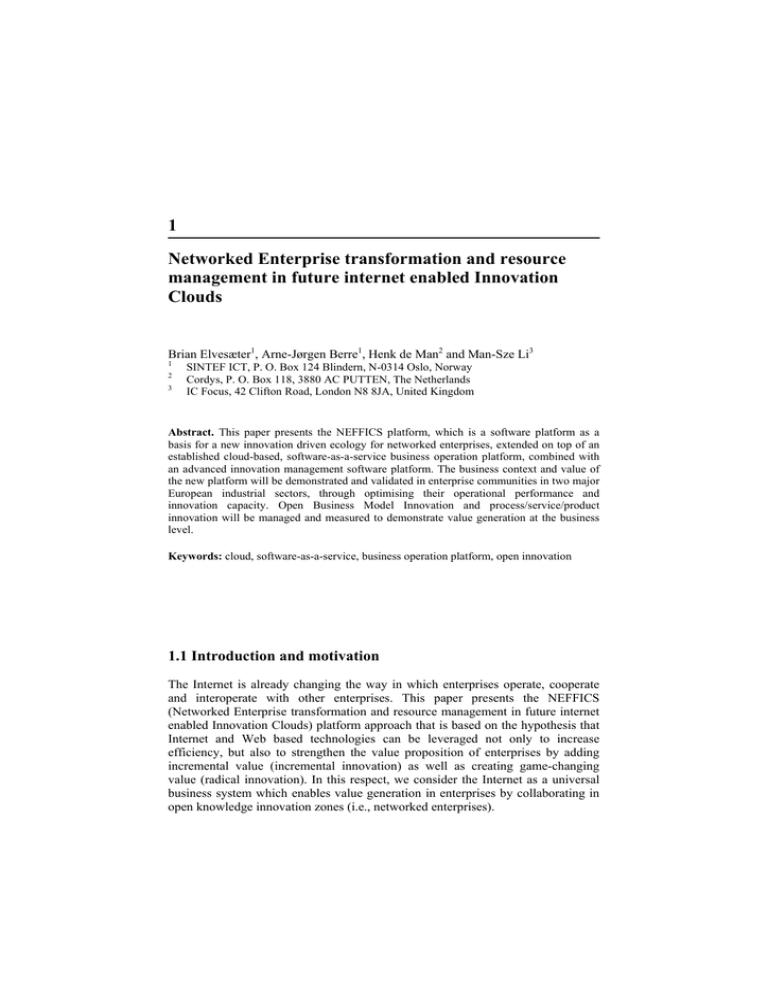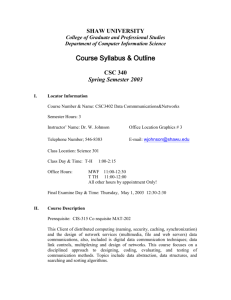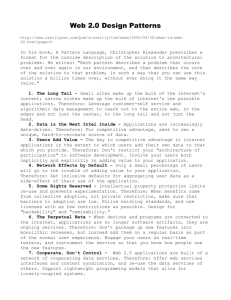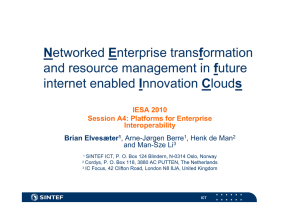1 Networked Enterprise transformation and resource management in future internet enabled Innovation Clouds
advertisement

1 Networked Enterprise transformation and resource management in future internet enabled Innovation Clouds Brian Elvesæter1, Arne-Jørgen Berre1, Henk de Man2 and Man-Sze Li3 1 2 3 SINTEF ICT, P. O. Box 124 Blindern, N-0314 Oslo, Norway Cordys, P. O. Box 118, 3880 AC PUTTEN, The Netherlands IC Focus, 42 Clifton Road, London N8 8JA, United Kingdom Abstract. This paper presents the NEFFICS platform, which is a software platform as a basis for a new innovation driven ecology for networked enterprises, extended on top of an established cloud-based, software-as-a-service business operation platform, combined with an advanced innovation management software platform. The business context and value of the new platform will be demonstrated and validated in enterprise communities in two major European industrial sectors, through optimising their operational performance and innovation capacity. Open Business Model Innovation and process/service/product innovation will be managed and measured to demonstrate value generation at the business level. Keywords: cloud, software-as-a-service, business operation platform, open innovation 1.1 Introduction and motivation The Internet is already changing the way in which enterprises operate, cooperate and interoperate with other enterprises. This paper presents the NEFFICS (Networked Enterprise transformation and resource management in future internet enabled Innovation Clouds) platform approach that is based on the hypothesis that Internet and Web based technologies can be leveraged not only to increase efficiency, but also to strengthen the value proposition of enterprises by adding incremental value (incremental innovation) as well as creating game-changing value (radical innovation). In this respect, we consider the Internet as a universal business system which enables value generation in enterprises by collaborating in open knowledge innovation zones (i.e., networked enterprises). 2 B. Elvesæter, A.-J. Berre, Henk de Man, Man-Sze Li Value creation through innovation lies at the heart of the approach. Already, there is a movement towards a broader concept of value creation beyond economic value, and defining new measurements for success beyond economic performance. For example, enterprises of the future will need to embrace the different perspectives of sustainability, because of customer demands and image, cost of raw material associated with natural resources, and likely regulatory developments that target specific environmental and social practices undertaken by enterprises. Such practices will increasingly have economic consequences and impact on the balance sheet of businesses. By the same token, enterprises will increasingly expect and demand ICT to meet a broader set of business objectives, other than cost reduction and efficiency improvement. ICT will need to support a new form of innovation so that growth is not purely profit-driven in the short term, but a sustainable value creation engine. The entire economic paradigm for business may change in the long run, leading to a fundamental transformation of how businesses are capitalised, assets are determined, stakeholders are involved; in short, a transformation of the notion of enterprises and therefore also the understanding of and approach to business models. Management of innovation is becoming a core concern, and business application innovation has to keep pace with and directly support business innovation. Traditional IT, and in particular ERP, does not adequately support transformation, management of knowledge work and participation in or management of networked enterprises. A new class of IT platforms, so-called Business Operation Platforms (BOP) [1] is emerging, and is better suited for these tasks. A BOP provides real-time connectivity in distributed environment, based on Service-oriented Architecture (SOA) in an Internet of Services context of the Future Internet [2]. It supports effective analysis through models and rapid implementation of change, partly by enabling application modularization and reuse through web services, and partly by adopting the paradigm of "what you model is what you execute“. BOP can be considered as the operating system to manage the business, from the cloud. The main contribution of the paper is to present the architecture for a platform that can support Innovation in Networked Enterprises, through the combination/integration/interoperability of two different existing platforms, a Business Operations Platform interoperating with an Innovation Community Platform. The business motivation for such platforms is in line with the analysis and recommendations of the Position Paper of the European Commission’s FInES Cluster [3]. 1.2 NEFFICS Architecture In our vision, future enterprise networks will be value networks, engaging suppliers, business partners and customers in (1) new kinds of value transaction; (2) new modes of exchange; (3) new organisation structures and models; and (4) new business practices. Compared to the existing supply chains, the value networks will be more open, flexible, adaptive, participatory and peer-to-peer. Networked Enterprise transformation and resource management in future internet enabled Innovation Clouds 3 These value networks will require a new generation of service platforms, which NEFFICS targets. 1.2.1 Vision The NEFFICS platform vision is to enable Enterprise Networks to be able to dynamically operate in cloud-based environments, independent of geographic location, with collaborative networked business operations support for knowledge workers and business services, integrated with real-time resource management for Internet of Services, Internet of Things/RFID and Internet of People from different partners, and linked directly to Innovation Community services. Based on the above vision, the specific problem that NEFFICS tries to solve is threefold: What is the foundation of such enterprise systems? How to enable their rapid adoption by enterprises? What are their benefits for enterprises? For the first, the NEFFICS system will be built using a Cloud-based paradigm and related innovation concepts for networked enterprises, based on a software platform running on top of a public Internet where basic, utility-like functionality for business operation can be assumed. For the second, NEFFICS will demonstrate how networked enterprises, can make management and innovation of their business more effective and efficient based on a Business Operations Platform combined with an Innovation Community Platform for open innovation [4] with associated methods and models. For the third, the business relevance and benefits of these results will be demonstrated and evaluated in two networked enterprise communities, and involving also additional stakeholders and communities, in respect of value generation, new business opportunities and the corresponding business models. 1.2.3 Approach and Architecture The NEFFICS platform will be based on the European Cordys Business Operations and MashApp platform [5], combined with the European Induct Innovation Community platform [6]. The NEFFICS platform will be extended from classical business processes to the support of Knowledge Worker processes and services that includes support for both Human and IT based processes and services. The platform will also be extended by innovation tools. The innovation tools will support both open innovation and community/group based innovation with various security and access levels. Both the Business Operations platform and the Innovation Community tools will be using an underlying Internet of Services for accessing business services. The NEFFICS platform will also integrate use of the Google Apps cloud platform and the Collaboration and Interoperability services platform from the European COIN project, Access to RFID/Sensors will be through the European ASPIRE project. NEFFICS will investigate several interlinked models and methods to support network-based business innovation. As a starting point, a value delivery model and 4 B. Elvesæter, A.-J. Berre, Henk de Man, Man-Sze Li methodology for networked business value delivery analysis will be used for a value analysis of the planned and the executing process and service models supported by the business operations platform. The value analysis will include a network based value model and support for a business ecology model with evaluation factors such as financial, business and social sustainability, performance, and quality (the OMG Business Ecology Initiative, amongst others, will be reviewed in this context). Bottleneck and improvement areas in the processes and services of the networked businesses will be identified as potential areas for innovation, and will be supported by complementary innovation management services. NEFFICS Community of highly innovative networked enterprises Applications for highly innovative networked enterprises Virtual Factory Network Networked process and service models Connected Retail Network Networked business value analysis models VDM Networked innovation models, leadership and management processes BPMN 2.0, SoaML, OSM, CMPM Networked enterprises MashApp applications and process support CEN/389 Networked innovation community services (Innovation Community Platform) Enterprise SaaS Cloud business operations and orchestration platform (Business Operations Platform) Google Apps/Waves, Cloud computing & Web 2.0 platform Networked Enterprises on Internet of Services and Things Fig. 1.1. Overview of the NEFFICS approach The NEFFICS platform, methods and models will be applied and evaluated in two different networked business applications: Virtual Factory Network: A virtual extended factory for a business network with integrated semantic sensor/RFID information through Vlastuin. Connected Retail Network: A connected retail network through Telecom Italia. The business benefits of the NEFFICS platform will be identified and evaluated in respect of each of the business application domain. Assessment of new business opportunities and the corresponding business models will be provided. Networked Enterprise transformation and resource management in future internet enabled Innovation Clouds 5 In addition, the NEFFICS platform, methods and models will be widely disseminated and will be validated by additional communities. NEFFICS will actively contribute to standardisation of the results. 1.3 NEFFICS Platform The NEFFICS platform will be based on the European Cordys Business Operations Platform (BOP) and the European Induct Innovation Community Platform (ICP). These two platforms will be combined, and extended from the support of single enterprises to the support of networked enterprises. 1.3.1 Business Operations Platform (BOP) The Cordys Business Operations Platform (BOP) is single platform that enables organizations to design, execute, monitor, change and continuously optimize critical business processes, services, applications and operations wherever they are deployed. The Cordys BOP is web-based and fully SaaS enabled, with no client implementation requirements other than a web browser. The platform is grid enabled and contains comprehensive master data management (MDM) capabilities, which ensures one version of the truth is used right across the enterprise, thereby reducing operational costs and delivering a complete, high-performance business process management enabled solution. BOP supports modelling and management of business processes, through models, based on various business process modelling paradigms. The following diagram provides an overview of the capabilities of the product. Fig. 1.2. Technical architecture 6 B. Elvesæter, A.-J. Berre, Henk de Man, Man-Sze Li The SaaS Deployment Framework (SDF) platform component enables dynamic provisioning of applications and rapid on-boarding of tenants; manages the relationships between applications, tenants and users; and measures (meters) utilization of billable entities. The Cordys Process Factory (CPF) platform component offers a simple, effective mechanism for anyone in the world to create and deploy situational applications and MashApps (mashups of Web-based, process-centric applications). The BOP provides a “unified” SOA-based server that serves as the repository and management facility for all artefacts generated throughout the process lifecycle. The system repository hosts and associates process models, development assets (such as integration code), configuration files and data transformation definitions. 1.3.2 Innovation Community Platform (ICP) The Induct Innovation Community Platform (ICP) is single platform that enables the creation of virtual social software-based innovation communities where ideas and challenges meet experience and knowledge. Employees with different skills and knowledge collaborate and develop ideas in an efficient way. By organizing your resources this way, companies can facilitate an environment where employees can utilize their competence, experience, and personal skills in areas where they are most talented. The result is increased productivity, employee satisfaction, and new levels of energy across the organization. Fig. 1.3. Innovation community ICP enables you to create, manage, and measure the entire innovation processes, including customizable task management, ensuring that steady progress toward goals is being maintained. You can define the implementation process into any number of different stage-gate phases based on various types of innovation. ICP supports a level of customization that is not available from other innovation management solutions. The entire system, including look, feel, help Networked Enterprise transformation and resource management in future internet enabled Innovation Clouds 7 text, innovation types and subtypes, ranking algorithms and innovation process can be customized with no programming required. The NEFFICS platform will integrate functionality of the Cordys BOP platform and the Induct ICP platform using a service-oriented interoperability approach over a cloud-based infrastructure to further develop collaborative means in the context of innovation management. As illustrated in Figure 1.1 the development of new networked innovation community services will take advantage of platform functionality from both the BOP and ICP platforms. 1.4 NEFFICS Use Case Scenarios The NEFFICS platform, methods and models will be driven by the needs of two user communities: Virtual Factory Network through Vlastuin, and Connected Retail Network through Telecom Italia. 1.4.1 Future Manufacturing Scenario The purpose of this case study is to develop a virtual extended factory (VEF) in the cloud supporting the (networked) value chain of a company in the Manufacturing Industry. The virtual extended factory makes use of cloud techniques to integrate business processes of the companies that participate in this VEF. Collaboration within and between companies will be supported by extended use of Web 2.0 technology. Chain-wide Business Process Innovation will be integrated part of the VEF solution. This is a new and innovative concept in the Manufacturing Industry, where most enterprises rely on old-fashioned ERP systems. This concept is innovative, not in the sense of developing new technology, but in the sense of using a combination of existing new technologies in a way that is not done before. 8 B. Elvesæter, A.-J. Berre, Henk de Man, Man-Sze Li Fig. 1.4. VEF environment – business perspective Vlastuin, a SME manufacturing company in the Metal Subcontracting Industry, has a lot of experience in aligning business processes and IT. Whereas the production departments adopted the Lean concept, the IT departments tried to implement this concept in the manufacturing software. During developing of this manufacturing software, the idea aroused that in theory it would be possible to integrate the purchase and production control processes. The main idea is to set up a virtual extended factory in the cloud that can be linked in an innovative way to business applications of other companies in the networked value chain. The business applications can be back-end systems that have to be at least partly opened to the cloud. These back-end systems can directly be linked to the VEF, but another option is to build a Cloud based business Process service Layer between the back-end systems and the VEF. 1.4.2 Future Retail Scenario Traditionally, manufacturers were the dominant forces in the supply chain in the consumer goods industry. With the trend toward retail consolidation and the emergence of large retailers, power in the supply chain has been shifting toward the retail level making Supply Chain Management a central node of the retail business [7]. Responding to this pull in a coordinated and efficient way, in order to avoid what in literature is known as “the bullwhip effect” [8], requires approaches known as Efficient Customer Response [9] (ECR) based on constant access to fresh information. Information availability is extremely important at all stages of the supply chain. For example, suppliers need information from the retailer on sales, inventory turnover, and feedback on competitors or on the level of customer returns. Information is also needed from consumers on attitudes toward the products, brand loyalty, willingness to pay, etc. Retailers need, for example, sales forecasts, information on product specifications, advance notice of new models, training materials for complex products, and information from consumers on their shopping needs, where else they shop and their satisfaction level with the retailer and the merchandise [10]. Retailers play a crucial role in collecting information on consumers, because they have direct contact with the customers at the point of sale and can collect information which goes beyond sales or scanning data and is important for marketing and logistics. They thus can traditionally act as gatekeepers in the supply chain who are able to control information flows. Networked Enterprise transformation and resource management in future internet enabled Innovation Clouds 9 Fig. 1.6. Interactions in a CRN The purpose of this case study in the context of NEFFICS is to develop a connected retail network (CR) in the cloud supporting the value chain of a company in the Fashion Industry. The connected retail makes use of cloud techniques to establish the connection between customer and supplier pushing the concept of ECR to its very edge and complementing retailers’ flow of information. This connection is complemented with the customers’ experiences inside premises ranging from directly operated flagship stores to franchising stores. Retailers and suppliers will also use cloud services to complement traditional enterprise resource planning systems (ERP) or merchandise information systems (MIS) already in place. Collaboration within the CR will be supported by extended use of Web 2.0 technology. Business Process Innovation will be integrated part of the CR solution. 1.5 Conclusions and Future Work The NEFFICS platform is starting from two of the most advanced Cloud and SaaS based platforms already available for Business Operations and Innovation Communities, from the European providers Cordys and Induct Software respectively. These two platforms will be combined, and extended from the support of single enterprises to the support of networked enterprises in the innovation clouds. The ideas presented in this paper are expected to be implemented in forthcoming activities involving the organisations mentioned in this paper. Future work will focus on a closer integration of the platforms and a practical evaluation 10 B. Elvesæter, A.-J. Berre, Henk de Man, Man-Sze Li and validation of the approach in the two application areas of future manufacturing and future retail. Strategically, the work could lead to the definition of value delivery models and innovation-centric business models. Future standardisation activities relate particularly to contribution to the OMG standardisation on a value chain metamodel (VDM), case management (CM) and Organisational structure modelling (OSM), as well as the CEN TC389 standard on Innovation Management. This paper presented the NEFFICS platform, which is based on cloud-enabled innovation. It is our belief (to be validated in forthcoming work) that will particularly benefit SMEs. The cloud is emerging as the new “business arena” where participants will join in innovating and operating their networked enterprise business. Cloud-based infrastructures will further contribute to improving sustainability in many different respects, of which “green IT” being one example. In summary, such infrastructures open up new value proposition and business opportunities for enterprise networks, which the NEFFICS platform will address. 1.6 References [1] [2] [3] [4] [5] [6] [7] [8] [9] [10] J. Pyke, "The Business Operations Platform Imperative", bpm.com. http://www.bpm.com/the-business-operations-platform-imperative.html (last visited 2009). Eurescom, "European Future Internet Portal", European Institute for Research and Strategic Studies in Telecommunications (Eurescom). http://www.futureinternet.eu/home.html (last visited 2009). M.-S. Li, M. Kürümlüoğlu, M. Mazura, and R. v. d. Berg, "Future Internet Enterprise Systems (FInES) Cluster Position Paper", European Commission, Information Society and Media, 1 September 2009. ftp://ftp.cordis.europa.eu/pub/fp7/ict/docs/enet/20090901-fines-positionpaper_en.pdf H. Chesbrough, "Open Business Models: How to Thrive in the New Innovation Landscape", Harvard Business School Press, USA, 2006. Cordys, "Business Operations Platform (BOP)", Cordys. http://www.cordys.com/cordyscms_com/business_operations_platform.php (last visited 2009). Induct Software, "Innovation Communities", Induct Software,. http://www.inductsoftware.com/InductWeb/index.aspx (last visited 2009). J. Zentes, D. Morschett, and H. Schramm-Klein, "Strategic Retail Management: Text and International Cases", Gabler, Betriebswirt.-Vlg, 2007, pp. 297-316. H. L. Lee, V. Padmanabhan, and S. Whang, "Information Distortion in a Supply Chain: The Bullwhip Effect", Management Science, vol. 43, no. 4, pp. 546-558, 1997. A. H. Kracklauer, D. Q. Mills, and D. Seifert, "Collaborative Customer Relationship Management: Taking CRM to the Next Level", Berlin, Springer, 2004, pp. 59. B. Berman and J. R. Evans, "Retail Management: A Strategic Approach", 10th ed., Upper Saddle River/NJ., Prentice Hall, 2007, pp. 226-227.







